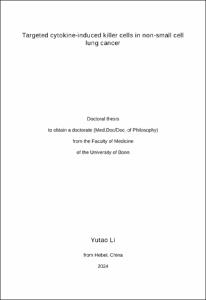Li, Yutao: Targeted cytokine-induced killer cells in non-small cell lung cancer. - Bonn, 2024. - Dissertation, Rheinische Friedrich-Wilhelms-Universität Bonn.
Online-Ausgabe in bonndoc: https://nbn-resolving.org/urn:nbn:de:hbz:5-75633
Online-Ausgabe in bonndoc: https://nbn-resolving.org/urn:nbn:de:hbz:5-75633
@phdthesis{handle:20.500.11811/11471,
urn: https://nbn-resolving.org/urn:nbn:de:hbz:5-75633,
doi: https://doi.org/10.48565/bonndoc-258,
author = {{Yutao Li}},
title = {Targeted cytokine-induced killer cells in non-small cell lung cancer},
school = {Rheinische Friedrich-Wilhelms-Universität Bonn},
year = 2024,
month = apr,
note = {STUDY I: A Combination of Cytokine-Induced Killer Cells With PD-1 Blockade and ALK Inhibitor Showed Substantial Intrinsic Variability Across Non-Small Cell Lung
Background: Cancer heterogeneity poses a serious challenge concerning the toxicity and adverse effects of therapeutic inhibitors, especially when it comes to combinatorial therapies that involve more than one targeted inhibitor. In particular, in non-small cell lung cancer (NSCLC), a number of studies have reported synergistic effects of drug combinations in the preclinical models, while they were only partially successful in the clinical setup, suggesting those alternative clinical strategies (with genetic background and immune response) should be considered. Herein, we investigated the antitumor effect of cytokine-induced killer (CIK) cells in combination with nivolumab and crizotinib in vitro on NSCLC cell lines.
Methods: We co-cultured the three genetically different NSCLC cell lines NCI-H2228 (EML4-ALK), A549 (KRAS mutation), and HCC-78 (ROS1 rearrangement) in the presence or absence of nivolumab and crizotinib. We profiled the variablity of surface expression multiple immune checkpoints, the concentration of absolute dead cell numbers, intracellular granzyme B on CIK cells by flow cytometry as well as mRNA by RT-qPCR. ELISA and western blot were applied to verify the activation of CIK cells.
Results: Our analysis showed that, a) nivolumab significantly weakened PD-1 surface expression on CIK cells without impacting other immune checkpoints or PD-1 mRNA expression. b) this combination strategy showed an effective response on cell viability, IFN-γ production and intracellular release of granzyme B in CD3+ CD56+ CIK cells, but solely in NCI-H2228, c) the intrinsic expression of Fas ligand (FasL) as a T-cell activation marker in CIK cells was upregulated by this additive effect. d) nivolumab induced Foxp3 expression in CD4+CD25+ subpopulation of CIK cells significantly increased. Taken together, we could show that CIK cells in combination with crizotinib and nivolumab can enhance the anti-tumor immune response through FasL activation, leading to increased IFN-γ and granzyme B, but only in NCI-H2228 cells with EML4-ALK rearrangement. Therefore, we hypothesize that CIK therapy may be a potential alternative in NSCLC patients harboring EML4-ALK rearrangement, in addition, we support the idea that combination therapies offer significant potential when they are optimized on a patient-by-patient basis (Published in Front Oncol. 2022;12: 713476).},
url = {https://hdl.handle.net/20.500.11811/11471}
}
urn: https://nbn-resolving.org/urn:nbn:de:hbz:5-75633,
doi: https://doi.org/10.48565/bonndoc-258,
author = {{Yutao Li}},
title = {Targeted cytokine-induced killer cells in non-small cell lung cancer},
school = {Rheinische Friedrich-Wilhelms-Universität Bonn},
year = 2024,
month = apr,
note = {STUDY I: A Combination of Cytokine-Induced Killer Cells With PD-1 Blockade and ALK Inhibitor Showed Substantial Intrinsic Variability Across Non-Small Cell Lung
Background: Cancer heterogeneity poses a serious challenge concerning the toxicity and adverse effects of therapeutic inhibitors, especially when it comes to combinatorial therapies that involve more than one targeted inhibitor. In particular, in non-small cell lung cancer (NSCLC), a number of studies have reported synergistic effects of drug combinations in the preclinical models, while they were only partially successful in the clinical setup, suggesting those alternative clinical strategies (with genetic background and immune response) should be considered. Herein, we investigated the antitumor effect of cytokine-induced killer (CIK) cells in combination with nivolumab and crizotinib in vitro on NSCLC cell lines.
Methods: We co-cultured the three genetically different NSCLC cell lines NCI-H2228 (EML4-ALK), A549 (KRAS mutation), and HCC-78 (ROS1 rearrangement) in the presence or absence of nivolumab and crizotinib. We profiled the variablity of surface expression multiple immune checkpoints, the concentration of absolute dead cell numbers, intracellular granzyme B on CIK cells by flow cytometry as well as mRNA by RT-qPCR. ELISA and western blot were applied to verify the activation of CIK cells.
Results: Our analysis showed that, a) nivolumab significantly weakened PD-1 surface expression on CIK cells without impacting other immune checkpoints or PD-1 mRNA expression. b) this combination strategy showed an effective response on cell viability, IFN-γ production and intracellular release of granzyme B in CD3+ CD56+ CIK cells, but solely in NCI-H2228, c) the intrinsic expression of Fas ligand (FasL) as a T-cell activation marker in CIK cells was upregulated by this additive effect. d) nivolumab induced Foxp3 expression in CD4+CD25+ subpopulation of CIK cells significantly increased. Taken together, we could show that CIK cells in combination with crizotinib and nivolumab can enhance the anti-tumor immune response through FasL activation, leading to increased IFN-γ and granzyme B, but only in NCI-H2228 cells with EML4-ALK rearrangement. Therefore, we hypothesize that CIK therapy may be a potential alternative in NSCLC patients harboring EML4-ALK rearrangement, in addition, we support the idea that combination therapies offer significant potential when they are optimized on a patient-by-patient basis (Published in Front Oncol. 2022;12: 713476).},
url = {https://hdl.handle.net/20.500.11811/11471}
}






